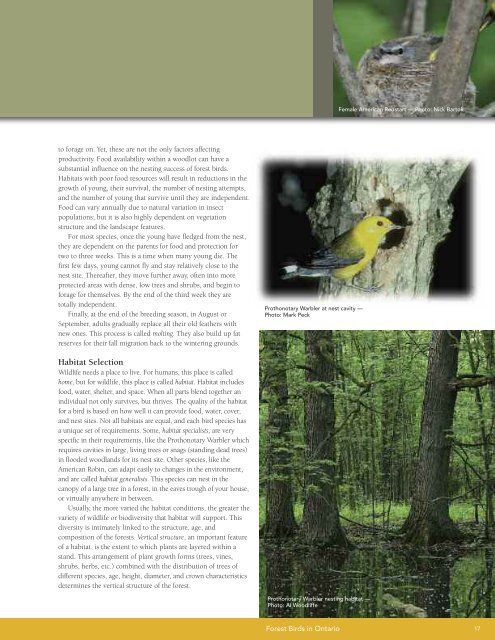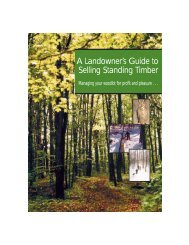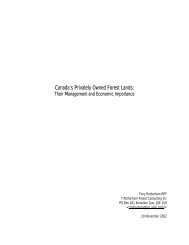A land manager's guide to conserving habitat for forest birds in ...
A land manager's guide to conserving habitat for forest birds in ...
A land manager's guide to conserving habitat for forest birds in ...
Create successful ePaper yourself
Turn your PDF publications into a flip-book with our unique Google optimized e-Paper software.
Female American Redstart — Pho<strong>to</strong>: Nick Bar<strong>to</strong>k<br />
<strong>to</strong> <strong>for</strong>age on. Yet, these are not the only fac<strong>to</strong>rs affect<strong>in</strong>g<br />
productivity. Food availability with<strong>in</strong> a woodlot can have a<br />
substantial <strong>in</strong>fluence on the nest<strong>in</strong>g success of <strong>for</strong>est <strong>birds</strong>.<br />
Habitats with poor food resources will result <strong>in</strong> reductions <strong>in</strong> the<br />
growth of young, their survival, the number of nest<strong>in</strong>g attempts,<br />
and the number of young that survive until they are <strong>in</strong>dependent.<br />
Food can vary annually due <strong>to</strong> natural variation <strong>in</strong> <strong>in</strong>sect<br />
populations; but it is also highly dependent on vegetation<br />
structure and the <strong>land</strong>scape features.<br />
For most species, once the young have fledged from the nest,<br />
they are dependent on the parents <strong>for</strong> food and protection <strong>for</strong><br />
two <strong>to</strong> three weeks. This is a time when many young die. The<br />
first few days, young cannot fly and stay relatively close <strong>to</strong> the<br />
nest site. Thereafter, they move further away, often <strong>in</strong><strong>to</strong> more<br />
protected areas with dense, low trees and shrubs, and beg<strong>in</strong> <strong>to</strong><br />
<strong>for</strong>age <strong>for</strong> themselves. By the end of the third week they are<br />
<strong>to</strong>tally <strong>in</strong>dependent.<br />
F<strong>in</strong>ally, at the end of the breed<strong>in</strong>g season, <strong>in</strong> August or<br />
September, adults gradually replace all their old feathers with<br />
new ones. This process is called molt<strong>in</strong>g. They also build up fat<br />
reserves <strong>for</strong> their fall migration back <strong>to</strong> the w<strong>in</strong>ter<strong>in</strong>g grounds.<br />
Prothonotary Warbler at nest cavity —<br />
Pho<strong>to</strong>: Mark Peck<br />
Habitat Selection<br />
Wildlife needs a place <strong>to</strong> live. For humans, this place is called<br />
home, but <strong>for</strong> wildlife, this place is called <strong>habitat</strong>. Habitat <strong>in</strong>cludes<br />
food, water, shelter, and space. When all parts blend <strong>to</strong>gether an<br />
<strong>in</strong>dividual not only survives, but thrives. The quality of the <strong>habitat</strong><br />
<strong>for</strong> a bird is based on how well it can provide food, water, cover,<br />
and nest sites. Not all <strong>habitat</strong>s are equal, and each bird species has<br />
a unique set of requirements. Some, <strong>habitat</strong> specialists, are very<br />
specific <strong>in</strong> their requirements, like the Prothonotary Warbler which<br />
requires cavities <strong>in</strong> large, liv<strong>in</strong>g trees or snags (stand<strong>in</strong>g dead trees)<br />
<strong>in</strong> flooded wood<strong>land</strong>s <strong>for</strong> its nest site. Other species, like the<br />
American Rob<strong>in</strong>, can adapt easily <strong>to</strong> changes <strong>in</strong> the environment,<br />
and are called <strong>habitat</strong> generalists. This species can nest <strong>in</strong> the<br />
canopy of a large tree <strong>in</strong> a <strong>for</strong>est, <strong>in</strong> the eaves trough of your house,<br />
or virtually anywhere <strong>in</strong> between.<br />
Usually, the more varied the <strong>habitat</strong> conditions, the greater the<br />
variety of wildlife or biodiversity that <strong>habitat</strong> will support. This<br />
diversity is <strong>in</strong>timately l<strong>in</strong>ked <strong>to</strong> the structure, age, and<br />
composition of the <strong>for</strong>ests. Vertical structure, an important feature<br />
of a <strong>habitat</strong>, is the extent <strong>to</strong> which plants are layered with<strong>in</strong> a<br />
stand. This arrangement of plant growth <strong>for</strong>ms (trees, v<strong>in</strong>es,<br />
shrubs, herbs, etc.) comb<strong>in</strong>ed with the distribution of trees of<br />
different species, age, height, diameter, and crown characteristics<br />
determ<strong>in</strong>es the vertical structure of the <strong>for</strong>est.<br />
Prothonotary Warbler nest<strong>in</strong>g <strong>habitat</strong> —<br />
Pho<strong>to</strong>: Al Woodliffe<br />
Forest Birds <strong>in</strong> Ontario 17

















